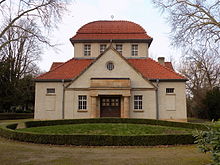New Jewish Cemetery (Worms)
The new Jewish cemetery (also Jüdischer Friedhof Worms-Hochheim ) is a Jewish cemetery in Worms . The cemetery, which was laid out in 1911 on the edge of the Hochheimer Höhe main cemetery, is now enclosed on three sides. Today the facility belongs to the Jewish Community of Mainz and is a listed building .
history
Since the old Jewish cemetery Heiliger Sand , located between the former city moat and the railway line, could no longer be expanded, the Jewish community in Worms tried to build a new cemetery from 1888 onwards. In 1910, she was able to contractually agree with the city of Worms that it would provide a plot of land on the eastern edge of the Hochheimer Höhe main cemetery, which was built in 1889, in exchange for a plot of land on Mainzer Straße acquired by the Jewish community for the construction of the cemetery.
The Jewish cemetery was integrated into the main cemetery by the city architect Georg Metzler , as Metzler hoped that the demarcation between the two parts of the cemetery could be omitted in the future. Metzler designed “a large, powerful burial place for the citizens of the city of Worms, of all denominations, in a uniform system”. Metzler also designed the mourning hall and gatehouse, both of which were completed in 1911.
On November 20, 1911, the city of Worms ceremoniously handed over the cemetery to the Jewish community. The consecration took place the day before, when a Jewish child was buried there on November 19. Both the Wormser Zeitung and the Jewish magazine Der Israelit devoted a report to this event a day later. In the 1920s the cemetery was expanded to the west. Between 1987 and 2005 the mourning hall and the gatehouse were restored. The cemetery is occupied to the present day and belongs to the Jewish community of Mainz today.
description

The cemetery lies on an elongated plot of land, the south side of which is closed off by a wall towards Eckenbertstrasse. In the central axis of the original property there is a portal through which one can get to the mourning hall via a forecourt. The gatehouse is located to the right of the portal. Behind the mourning hall there is a war memorial for the fallen of the First World War, to which the east-facing graves connect.
Mourning hall, portal, guard house and war memorial are kept in the forms of Darmstadt Art Nouveau . The front facade of the funeral hall, which was built in 1911 and is now a cultural monument, facing the forecourt is divided into several stages: A three-axis risalit is crowned by a large-format gable field with a round window. The middle section above the mourning hall is raised by one storey and is covered by a bell roof. The top of the building is completed by a Star of David . Above the column-supported main portal is the German and Hebrew inscription "Remember the prehistory - consider the years of the previous generations" ( Dtn 32.7 LUT ).
It was restored from 1987 to 2005.
The portal leads to the square mourning hall, a 9.50 m high central room, the side aisles and vestibule of which are separated by columns made of shell limestone. The walls are designed with elaborate ornamental plaster, which should create a festive atmosphere with the red sandstone floor and the wooden coffered ceiling. In the back wall of the mourning hall there is a conche for setting up the coffin, which is painted with Byzantine tendril ornaments. A double door inside the cone leads to a hallway that leads to the cemetery. On both sides of the vestibule and the corridor there are side rooms for the cemetery keepers and the storage of the dead and the washing of bodies . On the outside wall of the mourning hall there is a fountain for the ritual washing of hands .
The cemetery houses a war memorial for those who died in World War I, a field of honor for Jewish prisoners of war from Russia who died in Worms during World War I and a field for fourteen non-Jewish prisoners of war from the Soviet Union who died in Worms during World War II.
literature
- Gerold Bönnen : The memorial for those who died in World War I on the new Jewish cemetery in Worms and its significance in a regional comparison. In: Yearbook for West German State History, 32 (2006), pp. 367–396.
- Ralf-Quirin Heinz, Gerold Bönnen: 100 years of the Hochheimer Höhe main cemetery, Worms: 1902–2002. Festschrift for the 100th anniversary of the Hochheimer Höhe main cemetery in Worms. Stadtarchiv Worms , Worms 2003, ISBN 3-9809002-0-7 .
- Ulrich Knufinke: Buildings of Jewish cemeteries in Germany . Michael Imhof, Petersberg 2007. ISBN 978-3-86568-206-2 , pp. 250-252.
- Max Levy: On the history of the Worms Jewish community, its cemeteries and its burial system. Commemorative publication for the opening of the new cemetery. Worms 1911. ( Online )
Web links
Individual evidence
- ↑ General Directorate for Cultural Heritage Rhineland-Palatinate (ed.): Informational directory of cultural monuments - district-free city of Worms. ( Memento from June 13, 2018 in the Internet Archive ) Mainz 2018 [ Version 2020 is available. ] , P. 25 (PDF; 5.0 MB).
- ^ A b Carola Nathan and Christiane Rossner: A cemetery for everyone remained a vision. The Jewish mourning hall in Worms-Hochheim. German Foundation for Monument Protection, accessed on October 10, 2012 .
- ↑ Jörg Koch: Worms 100 years ago . Sutton , Erfurt 2012, ISBN 978-3-95400-020-3 , p. 19 .
- ↑ Knufinke, p. 252.
Coordinates: 49 ° 38 ′ 39.6 ″ N , 8 ° 20 ′ 16.4 ″ E
